manual transmission HONDA ACCORD COUPE 2017 9.G Quick Guide
[x] Cancel search | Manufacturer: HONDA, Model Year: 2017, Model line: ACCORD COUPE, Model: HONDA ACCORD COUPE 2017 9.GPages: 84, PDF Size: 7.3 MB
Page 53 of 84
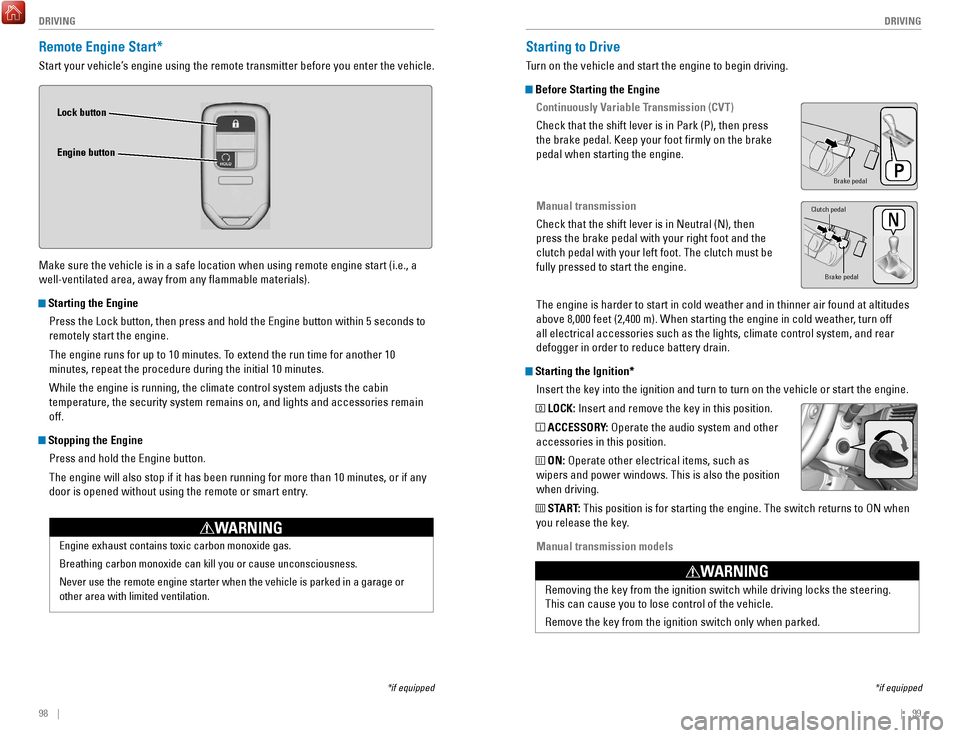
98 || 99
DRIVING
DRIVING
Remote Engine Start*
Start your vehicle’s engine using the remote transmitter before you enter the vehicle.
Make sure the vehicle is in a safe location when using remote engine start (i.e., a
well-ventilated area, away from any flammable materials).
Starting the Engine
Press the Lock button, then press and hold the
engine button within 5 seconds to
remotely start the engine.
The engine runs for up to 10 minutes. T
o extend the run time for another 10
minutes, repeat the procedure during the initial 10 minutes.
While the engine is running, the climate control system adjusts the cabi\
n
temperature, the security system remains on, and lights and accessories remain
off.
Stopping the Engine
Press and hold the
engine button.
The engine will also stop if it has been running for more than 10 minute\
s
, or if any
door is opened without using the remote or smart entry.
engine exhaust contains toxic carbon monoxide gas.
Breathing carbon monoxide can kill you or cause unconsciousness.
Never use the remote engine starter when the vehicle is parked in a gara\
ge or
other area with limited ventilation.
WARNING
Lock button
Engine button
*if equipped
Starting to Drive
Turn on the vehicle and start the engine to begin driving.
Before Starting the Engine Continuously Variable Transmission (CVT)
Check that the shift lever is in Park (P), then press
the brake pedal. Keep your foot firmly on the brake
pedal when starting the engine.
Manual transmission
Check that the shift lever is in Neutral (N), then
press the brake pedal with your right foot and the
clutch pedal with your left foot. The clutch must be
fully pressed to start the engine.
The engine is harder to start in cold weather and in thinner air found a\
t altitudes
above 8,000 feet (2,400 m). When starting the engine in cold weather, turn off
all electrical accessories such as the lights, climate control system, a\
nd rear
defogger in order to reduce battery drain.
Starting the Ignition*Insert the key into the ignition and turn to turn on the vehicle or star\
t the engine.
0 LOCK: Insert and remove the key in this position.
I ACCESSORY: operate the audio system and other
accessories in this position.
II ON: operate other electrical items, such as
wipers and power windows. This is also the position
when driving.
III START: This position is for starting the engine. The switch returns to oN when
you release the key.
Manual transmission models
*if equipped
Brake peda l
Brake pedal
Clutch pedal
removing the key from the ignition switch while driving locks the steerin\
g.
This can cause you to lose control of the vehicle.
remove the key from the ignition switch only when parked.
WARNING
Page 54 of 84
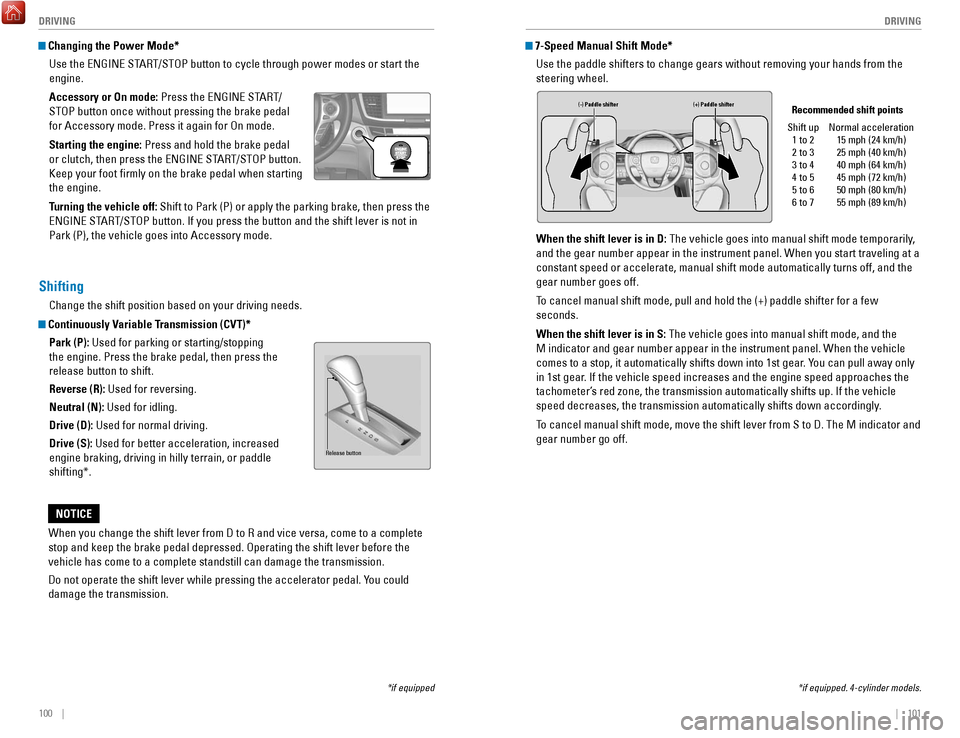
100 || 101
DRIVING
DRIVING
Changing the Power Mode*
Use the
eNGINe ST
A
rT/SToP button to cycle through power modes or start the
engine.
Accessory or On mode:
Press the
eNGINe ST
A
rT/
ST
oP button once without pressing the brake pedal
for Accessory mode. Press it again for
on mode.
Starting the engine:
Press and hold the brake pedal
or clutch, then press the
eNGINe ST
A
rT/SToP button.
Keep your foot firmly on the brake pedal when starting
the engine.
T
urning the vehicle off: Shift to Park (P) or apply the parking brake, then press the
eNGINe ST
A
rT/SToP button. If you press the button and the shift lever is not in
Park (P), the vehicle goes into Accessory mode.
*if equipped
Shifting
Change the shift position based on your driving needs.
Continuously Variable Transmission (CVT)*
Park (P): Used for parking or starting/stopping
the engine. Press the brake pedal, then press the
release button to shift.
Reverse (R): Used for reversing.
Neutral (N): Used for idling.
Drive (D): Used for normal driving.
Drive (S): Used for better acceleration, increased
engine braking, driving in hilly terrain, or paddle
shifting*.
When you change the shift lever from D to
r and vice versa, come to a complet
e
stop and keep the brake pedal depressed.
operating the shift lever before the
vehicle has come to a complete standstill can damage the transmission.
Do not operate the shift lever while pressing the accelerator pedal. Y
ou could
damage the transmission.
NOTICE
Release button
7-Speed Manual Shift Mode*
Use the paddle shifters to change gears without removing your hands from\
the
steering wheel.
When the shift lever is in D: The vehicle goes into manual shift mode temporarily,
and the gear number appear in the instrument panel. When you start trave\
ling at a
constant speed or accelerate, manual shift mode automatically turns off,\
and the
gear number goes off.
To cancel manual shift mode, pull and hold the (+) paddle shifter for a\
few
seconds.
When the shift lever is in S: The vehicle goes into manual shift mode, and the
M indicator and gear number appear in the instrument panel. When the veh\
icle
comes to a stop, it automatically shifts down into 1st gear. You can pull away only
in 1st gear. If the vehicle speed increases and the engine speed approaches the
tachometer’s red zone, the transmission automatically shifts up. If the vehicle
speed decreases, the transmission automatically shifts down accordingly.
To cancel manual shift mode, move the shift lever from S to D. The M indi\
cator and
gear number go off.
(-) Paddle shifter (+) Paddle shifter Recommended shift points
Shift up 1 to 2
2 to 3
3 to 4
4 to 5
5 to 6
6 to 7 Normal acceleration
15 mph (24 km/h)
25 mph (40 km/h)
40 mph (64 km/h)
45 mph (72 km/h)
50 mph (80 km/h)
55 mph (89 km/h)
*if equipped. 4-cylinder models.
Page 56 of 84
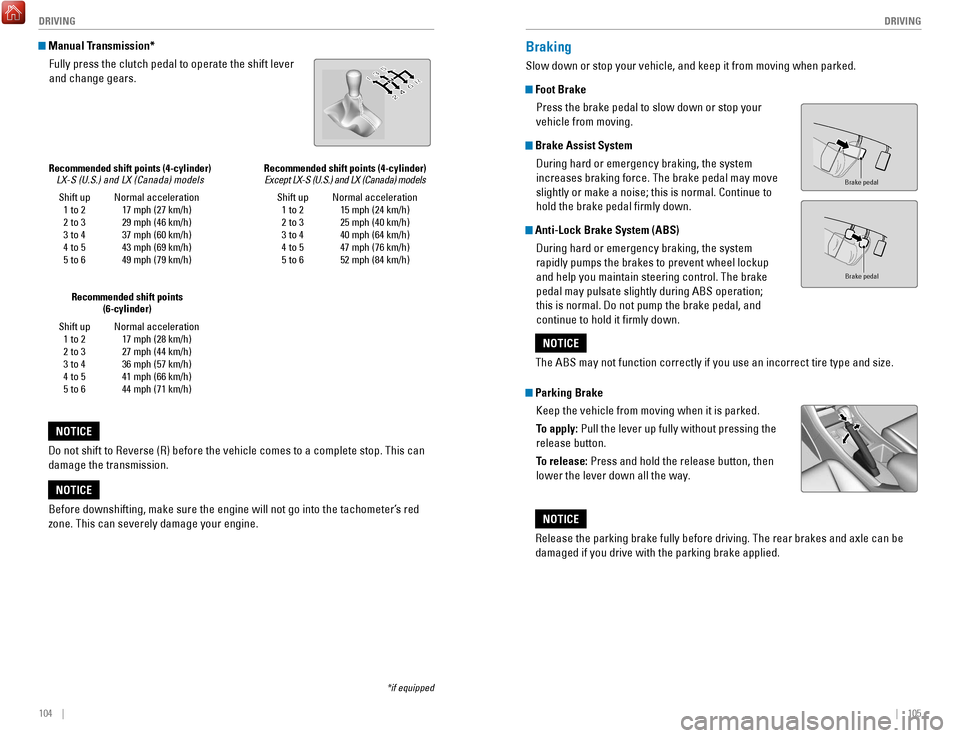
104 || 105
DRIVING
DRIVING
*if equipped
Shift up
1 to 2
2 to 3
3 to 4
4 to 5
5 to 6 Normal acceleration
17 mph (27 km/h)
29 mph (46 km/h)
37 mph (60 km/h)
43 mph (69 km/h)
49 mph (79 km/h)
Recommended shift points (4-cylinder)
LX-S (U.S.) and LX (Canada) models
Manual Transmission*
Fully press the clutch pedal to operate the shift lever
and change gears.
Do not shift to
reverse (r) before the vehicle comes to a complete stop. This can
damage the transmission.
NOTICE
Shift up 1 to 2
2 to 3
3 to 4
4 to 5
5 to 6 Normal acceleration
17 mph (28 km/h)
27 mph (44 km/h)
36 mph (57 km/h)
41 mph (66 km/h)
44 mph (71 km/h)
Recommended shift points
(6-cylinder)
Before downshifting, make sure the engine will not go into the tachomete\
r’s red
zone. This can severely damage your engine.
NOTICE
Braking
Slow down or stop your vehicle, and keep it from moving when parked.
Foot Brake
Press the brake pedal to slow down or stop your
vehicle from moving.
Brake Assist System During hard or emergency braking, the system
increases braking force. The brake pedal may move
slightly or make a noise; this is normal. Continue to
hold the brake pedal firmly down.
Anti-Lock Brake System (ABS) During hard or emergency braking, the system
rapidly pumps the brakes to prevent wheel lockup
and help you maintain steering control. The brake
pedal may pulsate slightly during ABS operation;
this is normal. Do not pump the brake pedal, and
continue to hold it firmly down.
Parking BrakeKeep the vehicle from moving when it is parked.
To apply: Pull the lever up fully without pressing the
release button.
To release: Press and hold the release button, then
lower the lever down all the way.
Brake peda l
Brake pedal
The ABS may not function correctly if you use an incorrect tire type and\
size.
NOTICE
release the parking brake fully before driving. The rear brakes and axle \
can be
damaged if you drive with the parking brake applied.
NOTICE
Shift up 1 to 2
2 to 3
3 to 4
4 to 5
5 to 6 Normal acceleration
15 mph (24 km/h)
25 mph (40 km/h)
40 mph (64 km/h)
47 mph (76 km/h)
52 mph (84 km/h)
Recommended shift points (4-cylinder)
Except LX-S (U.S.) and LX (Canada) models
Page 78 of 84
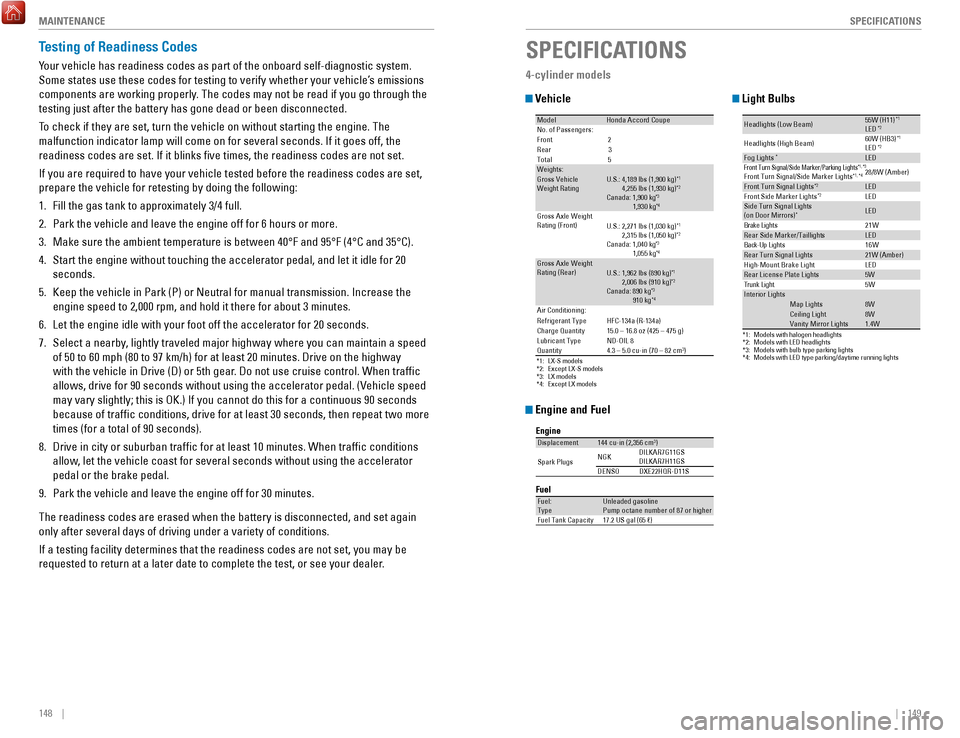
148 || 149
SPECIFICATIONS
M
AINTENANCE
Testing of Readiness Codes
Your vehicle has readiness codes as part of the onboard self-diagnostic s\
ystem.
Some states use these codes for testing to verify whether your vehicle’\
s emissions
components are working properly. The codes may not be read if you go through the
testing just after the battery has gone dead or been disconnected.
To check if they are set, turn the vehicle on without starting the engine\
. The
malfunction indicator lamp will come on for several seconds. If it goes \
off, the
readiness codes are set. If it blinks five times, the readiness codes \
are not set.
If you are required to have your vehicle tested before the readiness cod\
es are set,
prepare the vehicle for retesting by doing the following:
1.
Fill the gas tank to approximately 3/4 full.
2.
Park the vehicle and leave the engine off for 6 hours or more.
3.
Make sure the ambient temperature is between 40°F and 95°F (4°\
C and 35°C).
4.
Start the engine without touching the accelerator pedal, and let it idle\
for 20
seconds.
5.
Keep the vehicle in Park (P) or Neutral for manual transmission. Incre\
ase the
engine speed to 2,000 rpm, and hold it there for about 3 minutes.
6.
Let the engine idle with your foot off the accelerator for 20 seconds.
7.
Select a nearby, lightly traveled major highway where you can maintain a speed
of 50 to 60 mph (80 to 97 km/h) for at least 20 minutes. Drive on the \
highw
ay
with the vehicle in Drive (D) or 5th gear. Do not use cruise control. When traffic
allows, drive for 90 seconds without using the accelerator pedal. (
vehicle speed
may vary slightly; this is
oK.) If you cannot do this for a continuous 90 seconds
because of traffic conditions, drive for at least 30 seconds, then rep\
eat two more
times (for a total of 90 seconds).
8.
Drive in city or suburban traffic for at least 10 minutes. When traffi\
c conditions
allow
, let the vehicle coast for several seconds without using the accelerator
pedal or the brake pedal.
9.
Park the vehicle and leave the engine off for 30 minutes.
The readiness codes are erased when the battery is disconnected, and set\
again
only after several days of driving under a variety of conditions.
If a testing facility determines that the readiness codes are not set, y\
ou may be
requested to return at a later date to complete the test, or see your de\
aler
.SPECIFICATIONS
4-cylinder models
Vehicle
Engine and Fuel
Light Bulbs
*1: LX-S models
*2: Except LX-S models
*3: LX models
*4: Except LX models
ModelHonda Accord CoupeNo. of Passengers:
Front 2
Rear 3
Tota l5
Weights:Gross Vehicle
Weight Rating U.S.: 4,189 lbs (1,900 kg )*1 4,255 lbs (1,930 kg)*2Canada: 1,900 kg*3 1,930 kg*4Gross Axle Weight
Rating (Front )U.S.: 2,271 lbs (1,030 kg )*1 2,315 lbs (1,050 kg)*2Canada: 1,040 kg*3 1,055 kg*4Gross Axle Weight
Rating (Rear)U.S.: 1,962 lbs (890 kg )*1 2,006 lbs (910 kg)*2Canada: 890 kg*3 910 kg*4Air Conditioning:Refrigerant Type
Charge Quantity
Lubricant Type
Quantity HFC-134a (R-134a
)
15.0 – 16.8 oz (425 – 475 g) ND-OIL 8
4.3 – 5.0 cu-in (70 – 82 cm
3)
Engine
FuelDisplacemen t144 cu-in (2,356 cm3)
Spark Plugs NG
K DILKAR7G11GS
DILKAR7H11GS
DENSO DXE22HQR-D11 S
Fuel:
TypeUnleaded gasoline
Pump octane number of 87 or higher
Fuel Tank Capacity 17.2 US gal (65 �)
*1:Models with halogen headlights*2:Models with LED headlights*3:Models with bulb type parking lights*4: Models with LED type parking/daytime running lights
Headlights (Low Beam)55W (H11)*1LED*2
Headlights (High Beam) 60W (HB3)*1LE
D*2Fog Lights*LEDFront Turn Si gnal/Side Marker/Parking Ligh ts*1, *3Front Turn Signal/Side Marker Lights*1, *428/8W (Amber )
Front Turn Signal Light s*2LED
Front Side Marker Lights*2LE DSide Turn Signal Lights
(on Door Mirrors)*LE D
W12
sthgiL ekarB
Rear Side Marker/Taillight sLED
W61
sthgiL pU-kcaB
Rear Turn Signal Lights21W (Amber)
High-M ount Brake Light
Rear License Plate Light s5W
W5
thgiL knurT
In terior LightsMap Lights8WCeiling Light8WVanity Mirror Light s1.4W
LED
Page 79 of 84
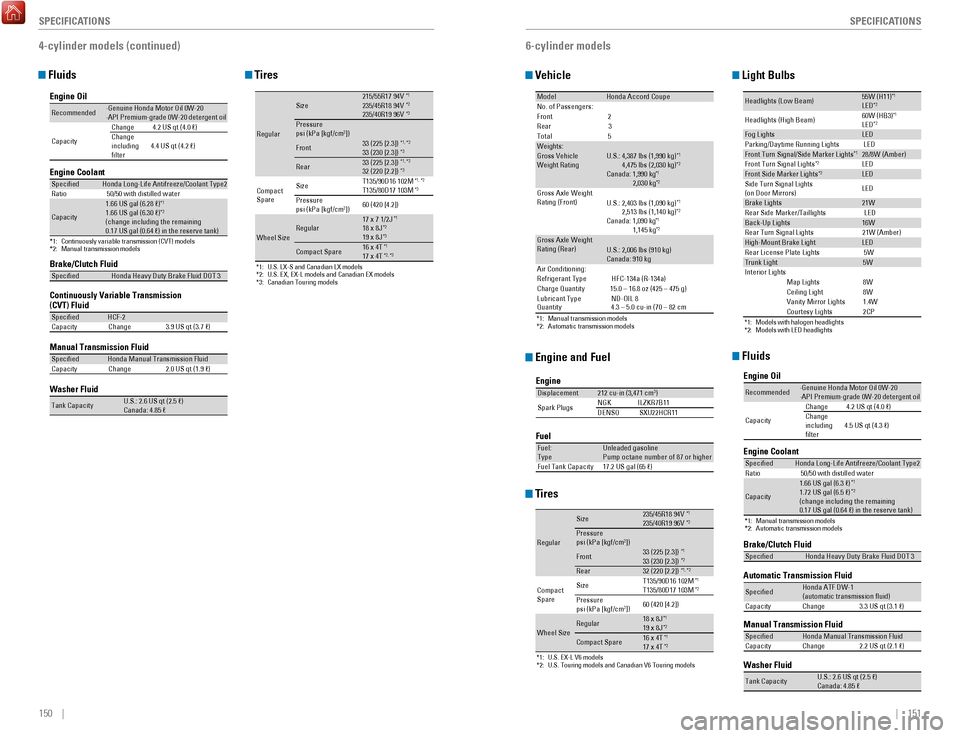
150 || 151
SPECIFICATIONS
SPECIFICATIONS
Fluids
4-cylinder models (continued)
Brake/Clutch Fluid
Continuously Variable Transmission (CVT) Fluid
Manual Transmission Flui
d
Speci�e
dHonda Heavy Duty Brake Fluid DOT 3
Speci�edHCF-2
Capacity Change 3.9 US qt (3.7 �)
Speci�edHonda Manual Transmission Flui d
Capacity Change 2.0 US qt (1.9 �)
Engine Oil
Engine Coolan
t
*1:Continuously variable transmission (CVT) models*2:Manual transmission models
Recommended·Genuine Honda Motor Oil 0W-2 0
·API Premium-grade 0W-20 detergent oi l
Capacity Change
4.2 US qt (4.0 �)
Change
including
�lter 4.4 US qt (4.2 �)
Speci�e
dHonda Long-Life Anti freeze/Coolant Type2Ratio 50/50 with distilled wate r
Capacity
1.66 US gal (6.28 �)*11.66 US gal (6.30 �)*2
(change including the remaining
0.17 US gal (0.64 �) in the reserve tank )
Washer Fluid
Tank CapacityU.S.: 2.6 US qt (2.5 �)
Canada: 4.85 �
6-cylinder models
Vehicle
Engine and Fuel
Tires
Light Bulbs
Fluids
*1: Manual transmission models
*2: Automatic transmission models
ModelHonda Accord Coup eNo. of Passengers:
Front 2
Rear 3
Tota l5
Weights:Gross Vehicle
Weight Rating U.S.: 4,387 lbs (1,990 kg )*1 4,475 lbs (2,030 kg)*2Canada: 1,990 kg*1 2,030 kg*2Gross Axle Weight
Rating (Front )U.S.: 2,403 lbs (1,090 kg )*1 2,513 lbs (1,140 kg)*2Canada: 1,090 kg*1 1,145 kg*2Gross Axle Weight
Rating (Rear)U.S.: 2,006 lbs (910 kg )
Canada: 910 kg
Air Conditioning:
Refrigerant Type HFC-134a (R-134a)
Charge Quantit y15.0 – 16.8 oz (425 – 475 g)
Lubricant Type ND-OIL 8
Quantity 4.3 – 5.0 cu-in (70 – 82 cm
Engine
FuelDisplacemen
t212 cu-in (3,471 cm3)
Spark Plugs NG
KI LZKR7B11
DENSO SXU22HCR11
Fuel:
TypeUnleaded gasoline
Pump octane number of 87 or higher
Fuel Tank Capacity 17.2 US gal (65 �)
*1: U.S. EX-L V6 models*2: U.S. Touring models and Canadian V6 Touring models
Regular
Size235/45R18 94 V*1235/40R19 96V*2Pressure
psi (kPa [kgf/cm2])
Front33 (225 [2.3])*133 (230 [2.3])*2Rear32 (220 [2.2])*1, *2
Compact
Spar e Size
T135/90D16 102M*1T135/80D17 103M*2Pressure
psi (kPa [kgf/cm2])
60 (420 [4.2])
Wheel SizeRegular18 x 8J*119 x 8J*2
Compact Spar
e16 x 4T*117 x 4T*2
*1: Models with halogen headlights*2: Models with LED headlights
Headlights (Low Beam)55W (H11)*1LED*2
Headlights (High Beam )60W (HB3
)*1LED*2Fog LightsLED
Parking/Da ytime Running Lights LED
Front Turn Signal/Side Marker Light s28/8W (Amber)
Front Turn Signal Light s*2LEDFront Side Marker Lights*2LED
Side Turn Signal Lights
(on Door Mirrors ) LE
D
Brake Lights21W
Rear Side Marker/Taillight sLED
Back-Up Lights16W
Rear Turn Signal Lights 21W (Amber)
High-Mount Brake LightLED
Rear License Plate Light s5W
Trunk Light5WInterior Light sMap Lights8WCeiling Ligh t8WVanity Mirror Lights1.4WCourtesy Light s2CP
*1
Brake/Clutch Fluid
Automatic Transmission Fluid
Manual Transmission Fluid
Speci�edHonda Heavy Duty Brake Fluid DOT 3
Speci�edHonda ATF DW- 1
(automatic transmission �uid )
Capacit yC hange3 .3 US qt (3.1 �)
Speci�edHonda Manual Transmission Flui d
Capacity Change 2.2 US qt (2.1 �)
Engine Oil
Engine Coolan
t
*1: Manual transmission models
*2: Automatic transmission models
Recommended·Genuine Honda Motor Oil 0W-20
·API Premium-grade 0W-20 detergent oi l
Capacity Change
4.2 US qt (4.0 �)
Change
including
�lter 4.5 US qt (4.3 �)
Speci�e
dHonda Long-Life Anti freeze/Coolant Type 2
Ratio 50/50 with distilled wate r
Capacity
1.66 US gal (6.3 �)*11.72 US gal (6.5 �)*2
(change including the remaining
0.17 US gal (0.64 �) in the reserve tank )
Washer Fluid
Tank CapacityU.S.: 2.6 US qt (2.5 �)
Canada: 4.85 �
Tires
*1:U.S. LX-S and Canadian LX models*2:U.S. EX, EX-L models and Canadian EX models*3: Canadian Touring models
Regular
Size215/55R17 94 V*1235/45R18 94V*2235/40R19 96V*3Pressure
psi (kPa [kgf/cm2])
Front33 (225 [2.3])*1, *233 (230 [2.3])*3
Rear33 (225 [2.3])*1, *232 (220 [2.2])*3
Compact
Spar e Size
T135/90D16 102M*1, *2T135/80D17 103M*3Pressure
psi (kPa [kgf/cm2])60 (420 [4.2])
Wheel SizeRegula
r17 x 7 1/2J*118 x 8J*219 x 8J*3
Compact Spar e16 x 4T*117 x 4T*2, *3
Page 83 of 84
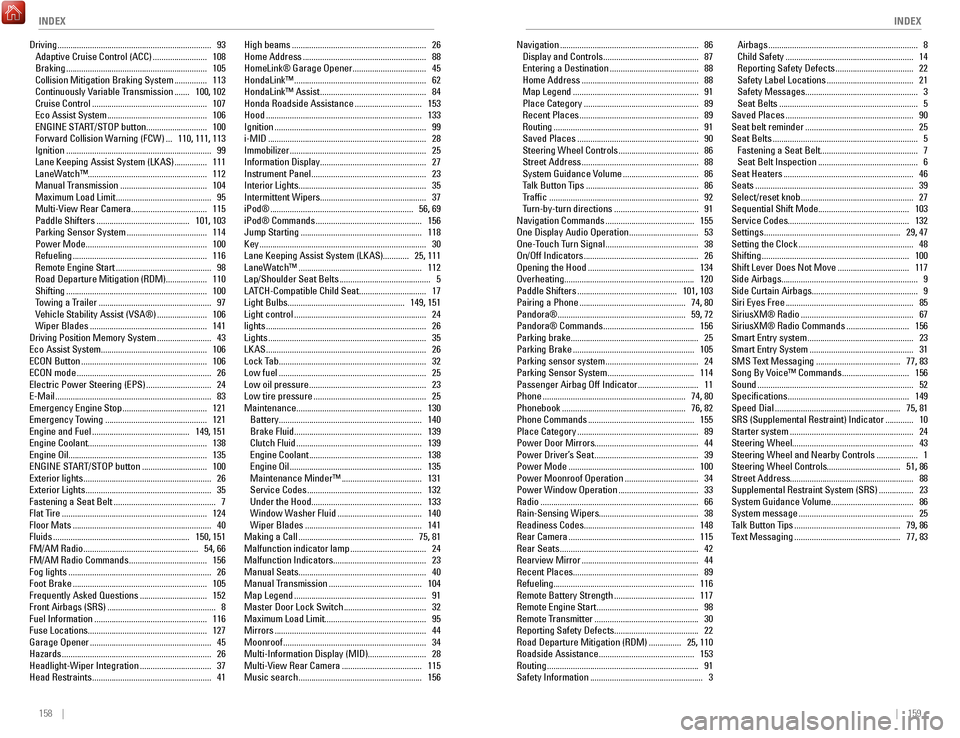
158 || 159
INDEX
INDEX
Driving ....................................................................... 93
Adaptive Cruise Control (ACC) ......................... 108
Braking ................................................................. 105
Collision Mitigation Braking System ............... 113
Continuously variable Transmission ....... 100
, 102
Cruise Control
..................................................... 107eco Assist System .............................................. 106eNGINe ST
A
rT/SToP button ............................ 100
Forward Collision W
arning (FCW)
... 110
, 111, 113
Ignition
................................................................... 99
Lane Keeping Assist System (LKAS) ............... 111
LaneW
atch™....................................................... 112
Manual Transmission
........................................ 104
Maximum Load Limit ............................................ 95
Multi-view rear Camera ................................... 115
Paddle Shifters ........................................... 101
, 103
Parking Sensor System
..................................... 114
Power Mode ........................................................ 100refueling .............................................................. 116remote engine Start ............................................ 98road Departure Mitigation (rDM)
................... 110
Shifting
................................................................. 100
T
owing a Trailer
.................................................... 97vehicle Stability Assist (vSA®) ....................... 106
Wiper Blades ...................................................... 141
Driving Position Memory System ......................... 43eco Assist System
................................................. 106
eCoN Button .......................................................... 106eCoN mode .............................................................. 26electric Power Steering (ePS) .............................. 24e-Mail ........................................................................\
83emergency engine Stop ....................................... 121emergency T
owing
............................................... 121engine and Fuel ............................................. 149
, 151
engine Coolant
....................................................... 138
engine oil
................................................................ 135
eNGINe ST
A
rT/SToP button .............................. 100exterior lights ........................................................... 26exterior Lights .......................................................... 35
Fastening a Seat Belt ............................................... 7
Flat T
ire
................................................................... 124
Floor Mats ................................................................ 40
Fluids ............................................................... 150
, 151
FM/AM
radio ..................................................... 54
, 66
FM/AM
radio Commands .................................... 156
Fog lights .................................................................. 26
Foot Brake .............................................................. 105
Frequently Asked Questions ............................... 152
Front Airbags (SrS) .................................................. 8
Fuel Information .................................................... 116
Fuse Locations
....................................................... 127
Garage
opener ........................................................ 45
Hazards ..................................................................... 26
Headlight-Wiper Integration ................................. 37
Head restraints ....................................................... 41High beams
..............................................................
26
Home Address ......................................................... 88
HomeLink® Garage opener .................................. 45
HondaLink™ ............................................................. 62
HondaLink™ Assist ................................................. 84
Honda roadside Assistance ............................... 153
Hood ........................................................................\
133
Ignition ...................................................................... 99
i-MID ........................................................................\
. 28
Immobilizer ............................................................... 25
Information Display
................................................. 27
Instrument Panel
..................................................... 23
Interior Lights
........................................................... 35
Intermittent Wipers................................................. 37
iPod®
.................................................................. 56
, 69
iPod® Commands
................................................. 156
Jump Starting ........................................................ 118
Key ........................................................................\
..... 30
Lane Keeping Assist System (LKAS)
............ 25, 111
LaneWatch™
......................................................... 112
Lap/Shoulder Seat Belts .......................................... 5
LATCH-Compatible Child Seat ............................... 17
Light Bulbs
...................................................... 149, 151
Light control
............................................................. 24
lights ........................................................................\
.. 26
Lights ........................................................................\
. 35
LKAS ........................................................................\
.. 26
Lock T
ab
.................................................................... 32
Low fuel .................................................................... 25
Low oil pressure ...................................................... 23
Low tire pressure .................................................... 25
Maintenance
.......................................................... 130
Battery
.................................................................. 140
Brake Fluid ........................................................... 139
Clutch Fluid .......................................................... 139engine Coolant .................................................... 138engine oil ............................................................. 135
Maintenance Minder™ ..................................... 131
Service Codes ..................................................... 132
Under the Hood ................................................... 133
Window Washer Fluid ....................................... 140
Wiper Blades ...................................................... 141
Making a Call ..................................................... 75
, 81
Malfunction indicator lamp
................................... 24
Malfunction Indicators
........................................... 23
Manual Seats........................................................... 40 Manual Transmission
........................................... 104
Map Legend ............................................................. 91
Master Door Lock Switch ...................................... 32
Maximum Load Limit............................................... 95
Mirrors
...................................................................... 44
Moonroof .................................................................. 34
Multi-Information Display (MID)
........................... 28
Multi-
view rear Camera ..................................... 115
Music search ......................................................... 156Navigation
................................................................
86
Display and Controls ............................................ 87entering a Destination ......................................... 88
Home Address ...................................................... 88
Map Legend .......................................................... 91
Place Category ..................................................... 89recent Places ....................................................... 89routing ................................................................... 91
Saved Places ........................................................ 90
Steering Wheel Controls ..................................... 86
Street Address ...................................................... 88
System Guidance volume ................................... 86
T
alk Button Tips
.................................................... 86
T
raffic
..................................................................... 92
T
urn-by-turn directions
....................................... 91
Navigation Commands ......................................... 155one Display Audio operation ................................ 53one-T
ouch Turn Signal ........................................... 38on/off Indicators ..................................................... 26opening the Hood ................................................. 134overheating
............................................................ 120
Paddle Shifters
.............................................. 101
, 103
Pairing a Phone
................................................. 74
, 80
Pandora®
........................................................... 59
, 72
Pandora® Commands
.......................................... 156
Parking brake........................................................... 25 Parking Brake
........................................................ 105
Parking sensor system ........................................... 24
Parking Sensor System ........................................ 114
Passenger Airbag off Indicator ............................ 11
Phone .................................................................. 74
, 80
Phonebook
......................................................... 76
, 82
Phone Commands
................................................. 155
Place Category ........................................................ 89
Power Door Mirrors
................................................ 44
Power Driver’s Seat
................................................ 39
Power Mode .......................................................... 100
Power Moonroof operation .................................. 34
Power Window operation ..................................... 33radio ........................................................................\
. 66rain-Sensing Wipers
.............................................. 38
readiness Codes
................................................... 148
rear Camera .......................................................... 115rear Seats ................................................................ 42rearview Mirror ...................................................... 44recent Places
.......................................................... 89
refueling
................................................................. 116
remote Battery Strength ..................................... 117remote engine Start ............................................... 98remote T
ransmitter
................................................ 30reporting Safety Defects
....................................... 22
road Departure Mitigation (rDM) ............... 25
, 110
roadside Assistance ............................................ 153routing ...................................................................... 91
Safety Information .................................................... 3Airbags
.....................................................................
8
Child Safety ........................................................... 14reporting Safety Defects .................................... 22
Safety Label Locations ........................................ 21
Safety Messages .................................................... 3
Seat Belts ................................................................ 5
Saved Places ........................................................... 90
Seat belt reminder .................................................. 25
Seat Belts ................................................................... 5
Fastening a Seat Belt ............................................. 7
Seat Belt Inspection .............................................. 6
Seat Heaters ............................................................ 46
Seats ........................................................................\
. 39
Select/reset knob .................................................... 27
Sequential Shift Mode
.......................................... 103
Service Codes........................................................ 132 Settings ............................................................... 29 , 47
Setting the Clock ..................................................... 48
Shifting .................................................................... 100
Shift Lever Does Not Move ................................. 117
Side Airbags............................................................... 9 Side Curtain Airbags................................................. 9
Siri
eyes Free ........................................................... 85
SiriusXM® radio .................................................... 67
SiriusXM® radio Commands ............................. 156
Smart entry system ................................................. 23
Smart entry System ................................................ 31
SMS T
ext Messaging
....................................... 77,
83
Song By
voice™ Commands ............................... 156
Sound ........................................................................\
52
Specifications ........................................................ 149
Speed Dial .......................................................... 75
, 81
S
rS (Supplemental restraint) Indicator ............. 10
Starter system ......................................................... 24
Steering Wheel
........................................................ 43
Steering Wheel and Nearby Controls
................... 1
Steering Wheel Controls
.................................. 51, 86
Street Address......................................................... 88 Supplemental
restraint System (SrS) ................ 23
System Guidance volume ...................................... 86
System message ..................................................... 25
T
alk Button Tips
................................................. 79
, 86
Text Messaging
................................................. 77
, 83